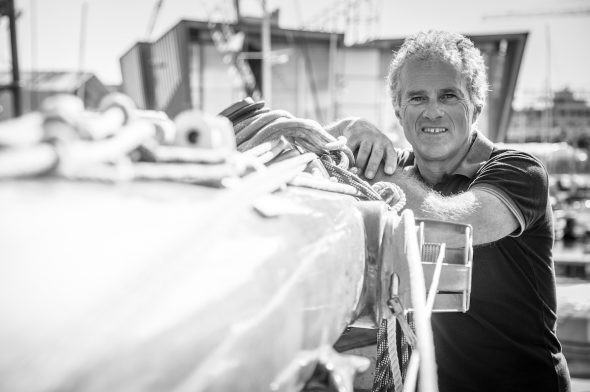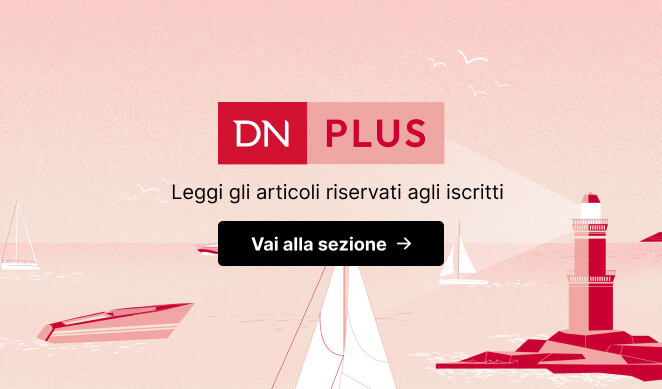Boating in a Portrait |Pietro D’Alì: “My love for sailing started with a rudimentary 3.50 metre spark”
He is the only Italian sailor to participate in the World Tour, the Olympics, the Louis Vuitton Cup and the final of the America’s Cup and other major events of international calibre.

Boating in a Portrait |Pietro D’Alì: “My love for sailing started with a rudimentary 3.50 metre spark”
He is the only Italian sailor to participate in the World Tour, the Olympics, the Louis Vuitton Cup and the final of the America’s Cup and other major events of international calibre.
Pietro D’Alì was born in Milan on 5 July 1963. He was raised in the Ligurian Riviera, and immediately discovered his passion for the sea and boating, navigating the family skiff at the age of 3 years old. A 7 years old, while holidaying in a windy location in Sicily, he had his first sailing experiences with a Spark (a small sailing dinghy with a mainsail and jib).
Having returned to the Riviera, he continued with the Optimist in the sailing school in Portofino. A 13 years old he became a part of the crew of the Guia IV, the boat owned by Giorgio Falck, where he became friends with Giovanni Verbini, known by everyone as Jepson, sailor by passion and profession, who had crossed all the oceans of the world as a faithful sailor of the ship’s owner.
Regatta in 420 and 470 he became Italian champion for both classes. In addition to going in the sailing dinghy, he never missed the chance to sail in other vessels and travel around the Mediterranean. Pietro D’Alì is one of the most complete sailors in Italy. He is the only Italian sailor to participate in the World Tour, the Olympics, the Louis Vuitton Cup and the final of the America’s Cup and other major events of international calibre, as well as a number of world, European, and national championships in wide range of classes (420, 470, Star, J22, J24, Asso 99, Laser SB3). He was also the only Italian in history to win a leg of the Solitaire du Figaro.
He participated in two editions of the America’s Cup with team Prada. In 2000 he was trimmer for the Luna Rossa in the final of the America’s Cup against Team New Zealand, after having been a part of the winning crew of the Louis Vuitton Cup. Having completed the race in 2000, he dedicated himself to the Star in light of the Sydney Olympics, where he came in tenth.
Since 2005, he has been competing on the Figaro Beneteau, monotype class for solitaire and couple competition, which is very popular in France. He participated in some of the most important regattas in the class, garnering significant experience and obtaining results never before achieved by Italian sailors in this type of competition.
Pietro D’Alì, your encounter with boating was very early on: at 3 years old you were already at the helm. Was all that salty air what you breathed in the family?
My maternal great-grandfather was a boat owner, of one of the last commercial sailing vessels, launched at the end of the Nineteenth century, and he owned a 16 metre cutter for pleasure boating. My parents were both water lovers, it was not difficult for them to pass on their passion for the water: it was innate, the problem was getting me out of the sea.
At 7 years you encountered sailing. What do you remember from those first experiences?
My grandfather’s holiday home in Sicily had a garden bordering with the rocky coastline, a buoy, and anchored to that “Scuffia”, a Spark, a small sailing dinghy about 3.50 metres long, built in Savona in ABS plastic, armed with a fore and aft mainsail and a jib, a very rudimentary boat.
It was love at first sight. Every morning when the sun came up, I swam out to the buoy, I raised the sails, untied it from the buoy and tacked in front of the house, until the morning breeze ended. Then I would go under water with my flippers and harpoon, looking for sole and red mullet. At noon we would grill the fish my father had caught in the garden. In the meantime a fresh breeze blew in from the sea.
When lunch was finished I began chomping at the bit to go out sailing, because I needed weight, I was too light. So I needed to convince my father to skip his siesta after having fished underwater; I was so insistent that I almost always won out in the end.
I had fun both going lightly and hearing the patter of the water off the bow in the morning breeze, as well as planing and dominating the strength of the sheets with the stronger afternoon wind, the mainsail did not have a cleat.
Already as a child I could feel the power of the sea. On one hand I respected it, with a certain cautiousness I was fearful, but on the other I wanted to test my abilities. I believe, that in steps, I was able to understand my limits and improve my knowledge, and this helps to manage the fear.
When the sea broke and the boat was hauled up against the rocks, I would go to the beach to swim in the breakers or I would train myself by jumping on the rocks, waiting for the right moment.
And then a brilliant career with victories, rankings, and satisfaction. When did you understand that your passion for sailing would also become your job?
Often, work wise, what the family desires, goes against your own aspiration, in my case, my maternal grandmother had an agricultural business near Milan and was hoping I would be interested in working there, that lasted a couple of years. In those days competitive sailing was different, my grandmother, as proud as she was of my achievements, reminded me that it wasn’t a job.
At that time she was right…But over time I found myself living on sailing alone. Competitive sailing is made of adrenaline: every time you win, passing your adversary, in the last few metres before the end, you get a bolt of adrenaline that makes your legs shake. Easy wins do not give the same feeling, more than if your boat is at the same level as your adversary that makes the difference.
Is there a regatta that you participated in that excited you more than others? Why?
In particular, I remember during the Solitaire, the victory of the Rochelle, considered to be the Mecca for sailing. At that time I took that leg from the French, in their own home, leaving 48 adversaries in my wake, on the third night of the regatta, after having duelled with the second in the last 40 miles.
The port was crowded with people to celebrate, so much so that I couldn’t get on the pier; I had five microphones pointed at me for the interview as soon as I had tied the mooring rope.
You could feel the Italy-France rivalry. I was “les italien”, the only foreigner to have won a leg in the history of the Solitaire, a record which I still hold. My arrivals in Spain and Ireland were not felt like that.
From the Optimist to the America’s Cup. What type of regatta and class are you most comfortable in and which do you enjoy most?
The Olympic classes are those that train the majority of the champions and I look to them with a great deal of interest. But you need to have time and means so that it can become your main activity; the physical part is important, Certainly if I were younger I would choose the 49er.
I like racing on both kinds of boat, slow displacements, with inertia and light planers. With the first the difference in speed is minimal, you play with small jumps in the wind, the deck and checking the adversary are fundamental, if the boat slows down, speeding back up again is costly. With fast boats, sailing where their is more winds prevails over changes in direction; you minimise manoeuvres, when you find the right speed you easily pass the other boats.
I enjoy being at the helm of any boat and trying to find the balance on the sails to bring it to its maximum potential, becoming one with the waves and the wind, anticipating adjustments and the helm so as not to lose balance, following the jumps in the wind and predicting those to come.
I have pleasant memories of the Giro d’Italia which has been great training for a few generations: a month of regatta in legs, with coastal or windward sailing in the arrival port the next day. An intense program, without any breaks, with professional crews. It was the time when the cities would name the boats and funded them together with a sponsor. Young people could financially manage their program.
What do they say about Pietro D’Alì in France? What is the relationship between the French and sailing?
For France it is still possible, for this reason offshore sailing in solitaire is a healthy sport and the Atlantic side has a large number of fleets of Mini, Class 40, Figaro, Open60 and trimarans.
In addition to the financial and political aspect, which focuses a lot on competitive sailing, in the wake of Tabarly, the French have kept a high level of interest for offshore sailing amongst the people, who as a base already have a developed seafaring culture. Live television, villages for departure, have given visibility to the sponsors, training centres and marinas with spaces reserved for competition boats have generated income for shipbuilding and an attraction for hobbyists.
The Figaro is the most competitive and professional class for solitaire. Every year sees the arrival of strong young people even from the Olympic classes, there are mature sailors who have over ten years of experience and stars of around my age, who are coming back to race in Solitaire, like Peyron, Desjoue, Gautier.
The route changes every year. But it is always between Normandy, The Channel, Ireland, Brittany, Northern Spain. Four legs between 400 and 600 miles long, with a couple of days’ rest in between. They always start with a technical route between buoys and bays to then continue on through other difficulties studied ad hoc by the organisers including shallow waters, islands, ships to avoid on the route, open sea and dangers along the coastline. All often between strong tidal currents. There is very little time for sleep, only the occasional power nap.
The French are prejudiced against Italians, but I presented myself with humility and then went strongly. This was recognised with sportsmanship. Once they gave me the nickname “Pietro Ferrari” in a magazine, and after having finished training, the “gladiator”.
The best compliment I received was from Kito with which we won the Transat ag2r: when the journalists, before departure asked him why he was running a double with an Italian, he answered that he would rather have me on board with him than against him.
The last race in Figaro was the Medsolo 2012, with a win in the Marseilles – Ajaccio leg and the Transat Jaquevabre or the Class 40 in couple 2013. The desire to return to the 51st Solitaire is there: after 15 years of Figaro 2, last year it was replaced by the Figaro 3 with foils.
Giuseppe Orrù
Photos by Claudio Colombo
BOATING IN A PORTRAIT A project by Liguria Nautica and Claudio Colombo showcasing a gallery of Ligurian people or those who have ties with our region, who have left their mark on Italian boating, or who have deep rooted connections with our sea. For each of them, we present a photographic portrait take by Claudio Colombo and an interview with our journalist, Giuseppe Orrù, to better know each person, in their personal lives as well.
Topics: Boating in a Portrait, Pietro D'Alì



